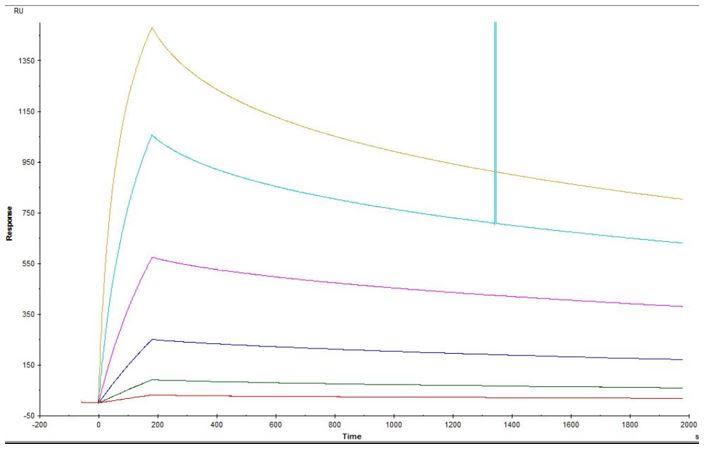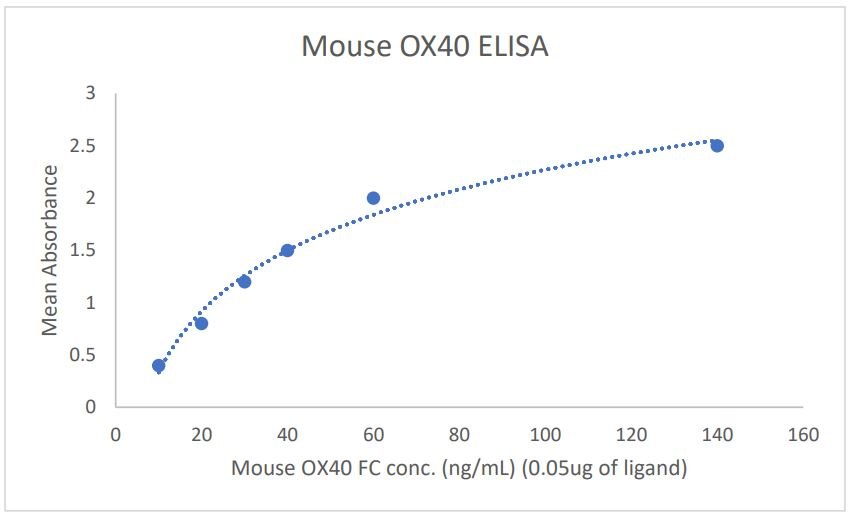Recombinant Mouse OX40/TNFRSF4 Fc Chimera Protein, CF Summary
Product Specifications
Analysis
Product Datasheets
Carrier Free
CF stands for Carrier Free (CF). We typically add Bovine Serum Albumin (BSA) as a carrier protein to our recombinant proteins. Adding a carrier protein enhances protein stability, increases shelf-life, and allows the recombinant protein to be stored at a more dilute concentration. The carrier free version does not contain BSA.
In general, we advise purchasing the recombinant protein with BSA for use in cell or tissue culture, or as an ELISA standard. In contrast, the carrier free protein is recommended for applications, in which the presence of BSA could interfere.
1256-OX
| Formulation | Lyophilized from a 0.2 μm filtered solution in PBS. |
| Reconstitution | Reconstitute at 100 μg/mL in sterile PBS. |
| Shipping | The product is shipped at ambient temperature. Upon receipt, store it immediately at the temperature recommended below. |
| Stability & Storage: | Store the unopened product at -20 to -70 °C. Use a manual defrost freezer and avoid repeated freeze-thaw cycles. Do not use past expiration date. |
Reconstitution Calculator
Background: OX40
OX40 (CD134; TNFRSF4) is a T cell co-stimulatory molecule of the TNF receptor superfamily that coordinates with other co-stimulators (CD28, CD40, CD30, CD27 and 4-1BB) to manage the activation of the immune response (1-3). Mouse OX40 cDNA encodes a 256 amino acid (aa) type I transmembrane glycoprotein with a 19 aa signal sequence, a 192 aa extracellular domain (ECD) that contains a cysteine-rich region, a 25 aa transmembrane segment, and a 36 aa cytoplasmic domain (4). The ECD of mouse OX40 shares 90% and 63% sequence identity with the ECD of rat and human OX40, respectively. OX40 is up-regulated on CD4+ and CD8+ T cells upon engagement of the TCR by antigen presenting cells along with co-stimulation by CD40-CD40 Ligand and CD28-B7 (5, 6). OX40 Ligand is primarily expressed on antigen presenting cells (5). OX40 Ligand engagement of OX40 on activated CD4+ T cells results in increased T cell survival, proliferation, and cytokine production. It also inhibits the conversion of effector T cells into immunosuppressive regulatory T cells (Tregs) and can promote the maintenance of and recall response in memory T cells (3, 7-10). OX40 is constitutively expressed on Tregs and enhances the sensitivity of Tregs to IL-2, thus promoting Treg proliferation. OX40 has also been shown to decrease the cells’ immunosuppressive activity on effector T cells (11-14). OX40-OX40 Ligand signaling is involved in allergic airway inflammation, graft-versus-host disease and autoimmune disease (6, 15, 16). Mutations in OX40 and OX40 Ligand are associated with cardiovascular disease (17, 18).
- Hori, T. (2006) Int. J. Hematol. 83:17.
- Latza, U. et al. (1994) Eur. J. Immunol. 24:677.
- Salek-Ardakani, S. et al. (2003) J. Exp. Med. 198:315.
- al-Shamkhani, A. et al. (1996) Eur. J. Immunol. 26:1695.
- Moran, A.E. et al. (2013) Curr. Opin. Immunol. 25:230.
- Gramaglia, I. et al. (1998) J. Immunol. 161:6510.
- Xiao, X. et al. (2008) J. Immunol. 181:3193.
- So, T. and M. Croft (2007) J. Immunol. 179:1427.
- Mousavi, S.F. et al. (2008) J. Immunol. 181:5990.
- Bansal-Pakala, P. et al. (2001) Nat. Med. 7:907.
- Piconese, S. et al. (2010) Eur. J. Immunol. 40:2902.
- Griseri, T. et al. (2010) J. Exp. Med. 207:699.
- Xiao, X. et al. (2012) J. Immunol. 188:892.
- Vu, M.D. et al. (2007) Blood 110:2501.
- Damayanti, T. et al. (2010) Am. J. Respir. Crit. Care Med. 181:688.
- Xiao, X. et al. (2012) Nat. Immunol. 13:981.
- Nakano, M. et al. (2010) Cardiovasc. Res. 88:539.
- Ishii, N. et al. (2010) Adv. Immunol. 105:63.
Citations for Recombinant Mouse OX40/TNFRSF4 Fc Chimera Protein, CF
R&D Systems personnel manually curate a database that contains references using R&D Systems products. The data collected includes not only links to publications in PubMed, but also provides information about sample types, species, and experimental conditions.
3
Citations: Showing 1 - 3
Filter your results:
Filter by:
-
Ligand-Blocking and Membrane-Proximal Domain Targeting Anti-OX40 Antibodies Mediate Potent T Cell-Stimulatory and Anti-Tumor Activity
Authors: P Zhang, GH Tu, J Wei, P Santiago, LR Larrabee, S Liao-Chan, T Mistry, ML Chu, T Sai, K Lindquist, H Long, J Chaparro-R, S Salek-Arda, YA Yeung
Cell Rep, 2019-06-11;27(11):3117-3123.e5.
Species: Mouse
Sample Types: In Vivo
Applications: mAb Generation -
OX40 Regulates Both Innate and Adaptive Immunity and Promotes Nonalcoholic Steatohepatitis
Authors: G Sun, H Jin, C Zhang, H Meng, X Zhao, D Wei, X Ou, Q Wang, S Li, T Wang, X Sun, W Shi, D Tian, K Liu, H Xu, Y Tian, X Li, W Guo, J Jia, Z Zhang, D Zhang
Cell Rep, 2018-12-26;25(13):3786-3799.e4.
Species: Mouse
Sample Types: In Vivo, Whole Cells
Applications: Bioassay, In Vivo -
Assembling OX40 aptamers on a molecular scaffold to create a receptor-activating aptamer.
Authors: Dollins CM, Nair S, Boczkowski D, Lee J, Layzer JM, Gilboa E, Sullenger BA
Chem. Biol., 2008-07-21;15(7):675-82.
Species: Mouse
Sample Types: RNA
Applications: Bioassay
FAQs
No product specific FAQs exist for this product, however you may
View all Proteins and Enzyme FAQsReviews for Recombinant Mouse OX40/TNFRSF4 Fc Chimera Protein, CF
Average Rating: 5 (Based on 2 Reviews)
Have you used Recombinant Mouse OX40/TNFRSF4 Fc Chimera Protein, CF?
Submit a review and receive an Amazon gift card.
$25/€18/£15/$25CAN/¥75 Yuan/¥1250 Yen for a review with an image
$10/€7/£6/$10 CAD/¥70 Yuan/¥1110 Yen for a review without an image
Filter by:
Reason for Rating: Analysis of the kinetics of the interaction between CD3-OX40Land OX40





